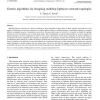237 search results - page 18 / 48 » Anonymous Networking with Minimum Latency in Multihop Networ... |
MOBIHOC
2007
ACM
14 years 6 months ago
2007
ACM
Existing work on the capacity of wireless networks predominantly considers homogeneous random networks with random work load. The most relevant bounds on the network capacity, e.g...
BROADNETS
2004
IEEE
13 years 10 months ago
2004
IEEE
We present a link layer protocol called the Multi-radio Unification Protocol or MUP. On a single node, MUP coordinates the operation of multiple wireless network cards tuned to no...
AEI
1999
13 years 6 months ago
1999
Multihop lightwave networks are a means of utilizing the large bandwidth of optical fibers. In these networks, each node has a fixed number of transmitters and receivers connected...
GLOBECOM
2006
IEEE
14 years 24 days ago
2006
IEEE
– Clustering is a standard approach for achieving efficient and scalable performance in wireless sensor networks. Most of the published clustering algorithms strive to generate t...
GLOBECOM
2010
IEEE
13 years 4 months ago
2010
IEEE
Opportunistic routing is a well-known technique that exploits the broadcast nature of wireless transmissions and path diversity to form the route in an adaptive manner based on cur...

